
Newsletter
September 2025
www.blindsa.org.za|011 839 1793|ceo@blindsa.org.za|5 Fuchs Street, Alrode Alberton
Thoughts From The Editorial Team
Humanity and all that goes with it, can be both joyful and brutal. There are times in everyone’s lives where all hope seems lost, but on the other side of the coin, there are times where happiness rules. In both these scenarios we make the choice to let life get us down, or to make a conscious decision to rise. Most times, caring about those around you, being helpful, kind and taking stock of what we bring to the table, releases endorphins, the “feel good” hormone, and quite naturally we start to feel good, hopeful and happy. Let us go into this world we live in. Be an example of what we need from each other and spread joy, empathy, hope and happiness.
“You must be the change you wish to see in the world” – Mahatma Gandhi
Happy reading all!!
Meet the people behind the scenes of your favourite Newsletter:

Editor: Karin Gouws – H.O.D.: Funding & Communications Email: funding.hod@blindsa.org.za; Cell: 067 057 9090
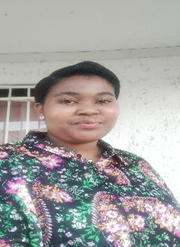
Assistant Editor: Lerato Jiyane – PR & Marketing Officer Email: pr@blindsa.org.za; Cell: 067 152 4592
CONTENTS
Touching History: Blind SA Partners with Iziko Museums to Enhance Accessibility 3
dbe hosts second engagement meeting with organisations representing persons with disabilities 5
Awareness in Action-From Campus to Airwaves 6
Understanding Retina Week & Retinal Health~ Love Your Eyes- Test Your Eyes 9
Albinism Awareness Month: Understanding the Impact on Vision 11
People with Disabilities and Domestic Violence 12
Article written by Dept. Women, Youth and Persons with Disabilities 12
Blind SA Marks Casual Day with Awareness, Inclusion and Partnership 15
A Seat at the Table: Disability Representation through D20 17
International Day of Sign Languages: Celebrating Inclusion and Communication 18
Turning Carbon into Opportunity: 3 Organization Harness the Power of the Spekboom Plant 19
Report on Dial-a-Ride Service Restrictions and Impact on the Blind Community 21
Suicide Awareness Month: Understanding the Impact on People with Visual Impairments 23
For social media Engagements please Follow us on: 25
Touching History: Blind SA Partners with Iziko Museums to Enhance Accessibility
Written By: Lerato Jiyane
From the 8th to the 12th of September 2025, Blind SA had the privilege of partnering with Iziko South African Museum in Cape Town to celebrate two milestones: the bicentenary of braille and 200 years of Iziko Museums. This collaboration highlighted the power of accessibility, inclusion, and heritage preservation in shaping a society where no one is excluded from cultural spaces.
The centrepiece of the celebration was the World Unseen Exhibition, a ground-breaking initiative by Canon South Africa in partnership with Blind SA & the British High Commission. The exhibition showcased Canon’s pioneering tactile print technology, which transforms visual artworks into textured, touchable pieces with the full description of the artwork in braille and audio, offering visitors who are blind or visually impaired a chance to experience art in new, meaningful ways. As braille marks 200 years of empowering independence and literacy, this exhibition extends the legacy by demonstrating how technology can expand accessibility into the cultural and artistic realms.

Figure 1: Image of attendees exploring the World Unseen exhibition.
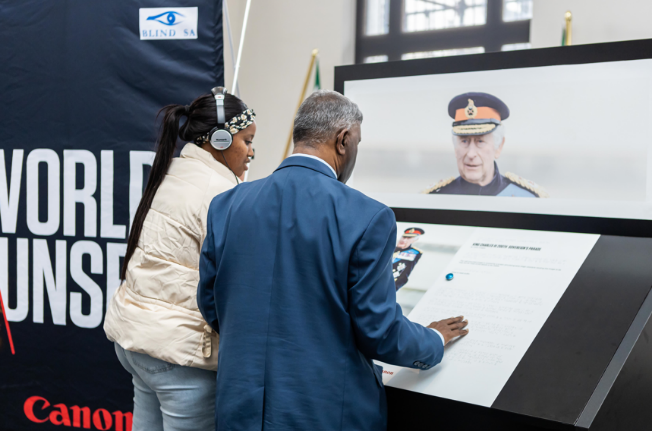
Figure 2: Image of Blind SA CEO & his PA at the exhibition.
As part of the programme, Blind SA hosted a workshop for curators, educators, and museum staff, over three days. The workshop provided practical tools on how to better engage blind and visually impaired audiences. Edit Microsystems presented on the range of assistive devices available, while Blind SA’s Braille Manager brought energy and fun by teaching participants about the braille cell through a creative activity using their body parts, the walkabout also featured ancient braille machines housed at the Antonnette Botha Braille Museum that date back from the early 1900s. The sessions also featured speakers who are visually impaired, who shared first-hand perspectives on global accessibility trends and highlighted the gaps that still exist in making museums truly inclusive.
Beyond the workshops, Blind SA participants and guests enjoyed the Iziko Planetarium and a guided museum tour, which underscored how museums can become fully inclusive spaces when intentional accessibility measures are built into their programmes.
Blind SA is deeply grateful to Iziko Museums for their hospitality, cultural stewardship, and commitment to inclusion, as well as to Canon South Africa, the British High Commission, and Edit Microsystems for their partnership and support. Together, these collaborations prove that accessibility is not just an add-on, but a collective responsibility.
As we look to the future, Blind SA hopes more museums will adopt this model of proactive accessibility. Universal design is vital: it is always better to design spaces and experiences that include persons with disabilities from the very beginning, rather than trying to retrofit or renovate later. By embracing universal design, we can ensure that museums and cultural institutions become spaces that belong to everyone.
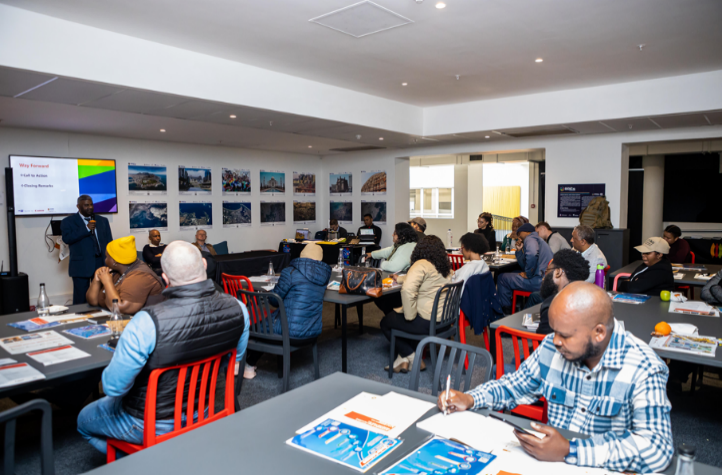
Figure 3: Image of attendees at the Workshop.
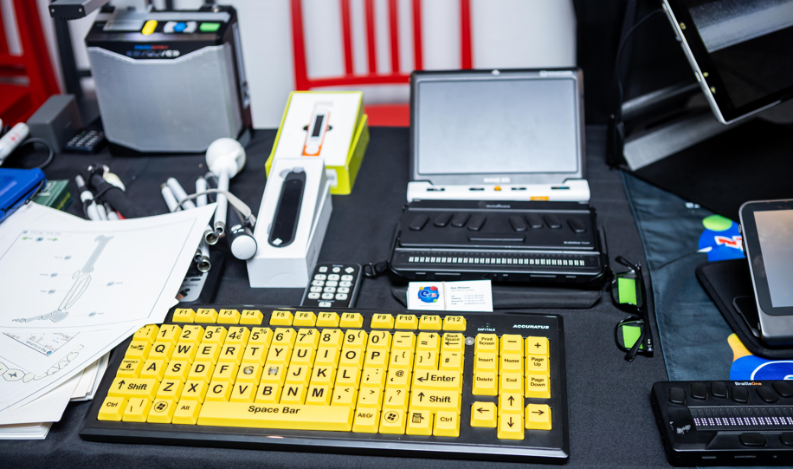
Figure 4:Image of Edit Microsystems Assistive devices on display.
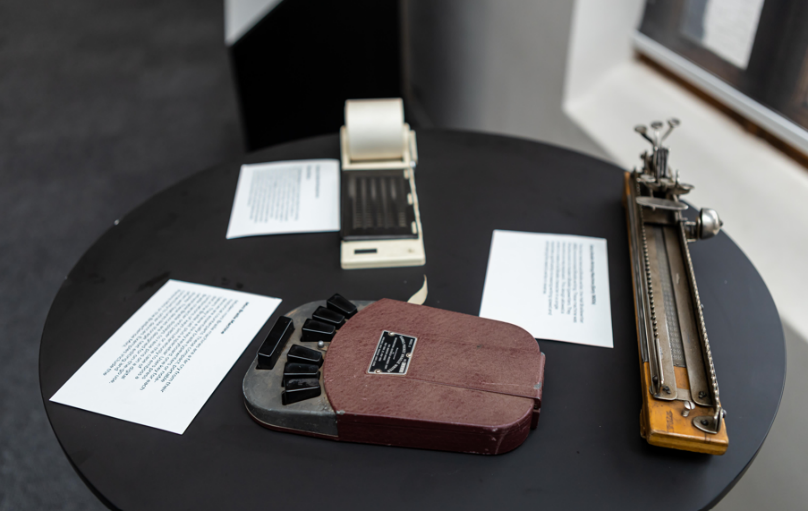
Figure 5: Image of ancient Braille machines
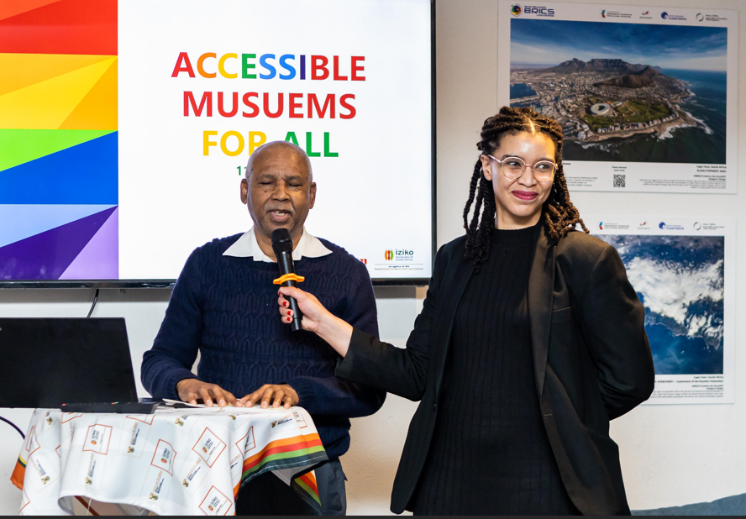
Figure 6: Image of Mr Abraham Allies addressing the attendees during the workshop & Ms Lindsay assisting with the mic
CTSB overall feedback is that the museum was very accommodating and easily accessible. The tour guide was helpful and descriptive and allowed for our students to take the time to experience, touch and feel the displays. The World Unseen Exhibition was wonderful and the students loved the fact that they could feel the tactile pictures, as well as read the braille description or listen to the audio too. – Marisa Teles – Social Worker CTSB
Some comments from 2 of her Students:
Franklin (Blind): “The experience at the museum was exciting. They were helpful and accommodating to those with visual disabilities. I would recommend it to anyone who has a disability to go and visit the museum and experience it. My Highlight was the visual photos that you could touch and feel the photo, that was quite interesting experience. Overall I would give it a thumbs up.”
Granville (Low Vision): “At first I thought that it would be difficult to move around as a visually impaired person but, I find it disabled friendly inside, as I was able to help a student in a wheelchair. It was my first time going into the museum and experiencing the displays. The tour guide was quite descriptive and went into detail about the displays. The audios in some of the displays (bees display and the whale sounds) was nice. The tactile pictures, what was nice about it was the braille that a blind person could read about the picture and if you can’t read braille there was audio that went into detail about the picture.”
dbe hosts second engagement meeting with organisations representing persons with disabilities
Extract of an Article provided by Dept. Basic Education
The DBE held its second stakeholder engagement meeting with organisations representing persons with disabilities at the DBE Conference Centre in Pretoria on 23 September 2025. Mr. Jabulani Ngcobo, Director for Inclusive Education, chaired the meeting, which discussed strategic issues of mutual concern aimed at accelerating the implementation of inclusive education in South Africa. In attendance were representatives from the Office of the General Director, Chief Director, Ms Lulama Ndabankulu and Director, Mr Livhuwani Mahada, as well as delegates from the Dept. of Women, Youth and Persons with Disabilities (DWYPD); DeafSA; Blind SA; Down Syndrome South Africa; The Rare Diseases Organisation; the South African Deaf Association; The Western Cape Forum for Intellectual Disability; and other stakeholders.
Presentations were made on key strategic interventions: ECD (Early Childhood Development), Progress on Inclusive Comprehensive Sexuality Education, STEM Subjects for Blind and Partially Sighted Learners, and the Review of Education White Paper 6.
To strengthen strategic and conceptual coherence in the implementation of inclusive education, the meeting established a task team that will drive advocacy efforts. The team comprises of representatives from the DBE and organisations representing person with disabilities. It was agreed that the team will need to come up with a decisive, targeted intervention to break down stigma, prejudice and discrimination against persons with disabilities to support the sector’s efforts at meeting its National and International obligations.
The meeting resolved to undertake the following: Hold an annual open meeting with organisations representing persons with disabilities.
The meeting reaffirmed the DBE’s commitment to working collaboratively with stakeholder to ensure inclusive education is realised in practice. The discussions and resolutions underscored the need for stronger advocacy, enhanced coordination and committed collaboration.
The next meeting is scheduled for 9 December 2025 at the DBE Conference Centre, Pretoria.
Awareness in Action-From Campus to radio Airwaves
Written By: Lerato Jiyane
Blind SA, in partnership with the University of Pretoria, proudly hosted the Disability Rights Awareness event on 4 September 2025 at the Old Chemistry Building Library. The day served as a vibrant platform for awareness, advocacy, and education, reinforcing the shared vision of an inclusive and accessible society for all. The event aimed to raise awareness about visual impairments, while also highlighting the importance of assistive technology, accessible learning, and inclusive education. Through interactive sessions, participants were invited to experience and better understand the daily realities of persons who are blind or partially sighted. Blind SA delegates brought expertise, passion, and creativity to every session:
- Mr. Ofentse Manyane led the Braille 200 presentation and participated in the Beyond the Label panel discussion, sharing powerful insights on accessibility and empowerment.
- Mr. Teboho Lehasa delivered an impactful presentation on Economic Empowerment and the Monate Sensory Flavours initiative experience.
- Mr. Johan Venter conducted an engaging Braille Lesson activity, giving attendees hands-on exposure to tactile literacy.
- Mr. Roedolph Britz showcased a range of Assistive Devices, demonstrating how technology can enhance independence.
- Blind SA Interns Ms. Londiwe Majola led the Monate Sensory Flavours Demonstration, while Ms. Sibongile Mbatha and Mr Lunga Thwala provided logistical and technical support throughout the day.
The programme opened with addresses from both University of Pretoria and Blind SA representatives, emphasizing the collective responsibility to advance disability rights. Engaging awareness presentations and interactive demonstrations followed, allowing participants to explore Braille, sensory experiences, and assistive devices first-hand.
A key highlight was the panel discussion “Beyond the Label,” where visually impaired professionals and students shared personal journeys of overcoming challenges and achieving excellence.
Adding a special touch of media presence, Mr. Manyane & Mr. Lehasa took to the airwaves with an exclusive interview on TUKs FM, where they discussed on the 200-year legacy of braille & the food tasting panellists. The Blind SA team participation on-air helped amplify the event’s message to a wider audience. The event successfully:
- Enhanced understanding of visual disability within the university community.
- Empowered blind and partially sighted individuals to share their experiences and advocate for inclusion.
- Promoted the use of accessible formats, like Braille, to enhance learning and communication.
- Ignite hope and commitment to visually impaired youth in the academic space & those with dreams to live independent lives.
The event was a resounding success, celebrating inclusion, education, and empowerment. It showcased the transformative impact of collaboration between educational institutions and advocacy organizations, reaffirming that true inclusion begins with awareness and ends with action. Remember that, Accessibility is not just a feature; it’s a right.
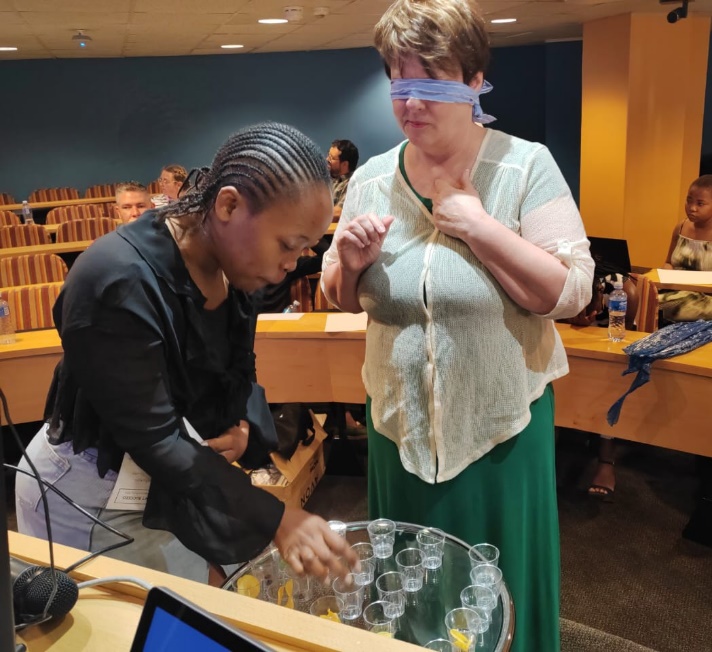
Figure 7: Londiwe at assisting an attendee to taste various flavours

Figure 8: Ofentse with UP students during the panel Discussion

Figure 9: Ofentse & Teboho at the TUKS FM studios during the Radio Interview
Understanding Retina Week & Retinal Health~ Love Your Eyes- Test Your Eyes
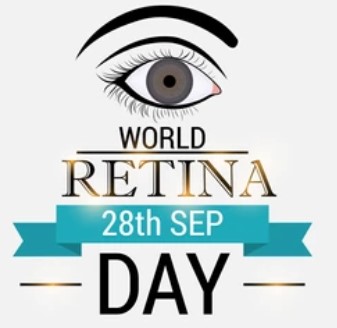
Figure 10: Image of Retina Day with an eye at top centre
World Retina Week is observed in South Africa typically in normally in the last week of September as a way to raise awareness about retinal diseases-what they are, how they can affect people’s sight, and what can be done to slow, treat, or prevent vision loss. Retina South Africa, together with ophthalmological societies, uses this occasion to educate the public, promote early eye examination, support research, and advocate for access to care.
What Is the Retina & Why It Matters
- The retina is a thin membrane at the back of the eye. It contains light-sensitive cells (rods and cones) that convert light into electrical signals which are sent to the brain so we can see.
- If the retina is damaged by disease, degeneration, or other causes, vision can be compromised, sometimes irreversibly. Early detection and management are therefore critical.
Common Retinal Conditions & How They Can Lead to Vision Loss or Blindness
Here are several of the retinal diseases frequently highlighted during Retina Week, and how they affect sight:
| Condition | Key Characteristics | How It Can Lead to Vision Loss / Blindness |
|---|---|---|
| 1.Retinitis Pigmentosa (RP) | A group of inherited disorders that gradually destroy the retina’s rod cells (responsible for low light and peripheral vision) and later cones. Vision often deteriorates slowly. | Night blindness, loss of peripheral vision – “tunnel vision” – possible complete vision loss over many years. No cure currently, though research is ongoing. |
| 2.Usher Syndrome | Genetic disease combining hearing loss and vision loss (because of RP). | Progressive vision loss due to retinal degeneration, often leads to severe visual impairment as one age. |
| 3.Diabetic Retinopathy | Damage to retinal blood vessels caused by long-term high blood sugar levels. | Can lead to swelling, bleeding in the retina, retinal detachment, and ultimately severe vision loss or blindness if untreated. |
| 4.Myopia (Severe / Progressive Myopia) | Near sightedness (distant objects are blurred). When myopia is high or worsening, retinal stretching can happen. | High myopia increases risk of complications such as retinal detachment, myopic maculopathy, cataract formation, and other pathologies that may lead to partial or sometimes severe vision loss. |
Risks, Warning Signs & Who Is Affected
- Retinal disease affects all demographic groups: young and old, rich and poor. In South Africa many of these conditions go unrecognized until damage is established.
- People with diabetes, those who smoke, those with family history of retinal disease, or those with high myopia are at greater risk. Warning signs can include: blurred central vision, difficulty seeing at night, loss of peripheral vision, distorted vision, floaters or flashes, changes in colour perception. Because some retinal conditions progress slowly or are asymptomatic at first, routine eye exams are essential.
Prevention, Early Detection & Management
While some retinal diseases have no cure, many strategies exist that can preserve vision or slow progression:
- Regular eye check-ups with an optometrist or ophthalmologist – catch changes early.
- Lifestyle choices: controlling blood sugar (for diabetics), managing blood pressure and cholesterol, avoiding smoking, eating a healthy diet rich in antioxidants, protecting eyes from excessive UV and blue light.
- Genetic testing and counselling – especially for inherited retinal conditions, to identify risk, guide potential treatments, and prepare for future therapies.
- Public education & awareness – so people are aware of symptoms, risk factors, and that early visits to eye health professionals can make a difference. Retina South Africa emphasises this during Retina Week.
Retinal diseases represent a serious threat to vision in South Africa and globally. While some conditions are currently untreatable, early detection, healthy lifestyle, access to adequate eye care, and ongoing scientific research offer realistic hope for reducing the burden of blindness. World Retina Week is a critical reminder that sight is precious – and preventing or delaying vision loss is possible.
Albinism Awareness Month: Understanding the Impact on Vision
Written By: Lerato Jiyane

Figure 11: Image of an Albino girl on green and yellow poster titled-National Albinism Awareness Month- September 2025
September marks Albinism Awareness Month in South Africa, a time dedicated to educating the public about albinism, dispelling myths, and promoting inclusion. While the condition is often misunderstood, one of the most significant yet less spoken-about aspects of albinism is its impact on vision.
Albinism is a rare genetic condition caused by a lack of melanin, the pigment responsible for colouring the skin, hair, and eyes. Melanin also plays a vital role in the healthy development of the eyes. Because of reduced or absent pigment, individuals with albinism often experience several visual challenges, including:
- Photophobia (sensitivity to light): Without sufficient pigment, the eyes allow too much light in, causing discomfort and difficulty seeing in bright environments.
- Nystagmus: Rapid, involuntary eye movements that can make it hard to focus on objects clearly.
- Reduced visual acuity: Many people with albinism have blurred or limited central vision, which cannot always be fully corrected with glasses.
- Strabismus: Misalignment of the eyes, sometimes referred to as “crossed eyes.”
- Difficulty with depth perception: This can affect mobility, sports, and certain everyday tasks.
These visual challenges highlight the need for specialized support, such as prescription glasses, magnifiers, large-print or braille materials, and orientation and mobility training. Schools and workplaces can also make a difference by providing accessible learning and working environments; hence Blind SA is always actively involved in spreading awareness through sensitization workshops and offering services such as Orientation & Mobility , Skills of Daily Living, sales & repairs of assistive devices.
Albinism Awareness Month is not only about raising visibility but also about ensuring that people with albinism receive the tools and support they need to live full, independent lives. By understanding the condition’s impact on vision, we can help create a more inclusive society that values dignity, accessibility, and equal opportunity.
People with Disabilities and Domestic Violence
Article written by Dept. Women, Youth and Persons with Disabilities
Domestic violence can impact anyone. However, the challenges, resources, and support offered can greatly vary based on the situation someone is in. People with disabilities and domestic violence intersect in many ways. It’s important to know the specific challenges they face, why it’s important to understand their unique experiences, and ways to help.
Why It Matters
Women with disabilities are uniquely vulnerable to all forms of violence, including intimate partner violence. They are significantly more likely to experience physical, sexual, and psychological abuses and stalking than their peers without disabilities. They are also more likely to experience intimate partner control of reproductive and sexual health than women without disabilities.
Men with disabilities are more likely to experience stalking and psychological abuse than their peers without disabilities.
Furthermore, violence against people with disabilities is not recognized by society to be a significant problem, and the needs of victims and survivors are often ignored. Barriers to accessing services compound the impact of violence against people with disabilities.
Six Facts About People with Disabilities and Domestic Violence
Did you know…
- People with disabilities have a higher lifetime prevalence of experiencing abuse than people without disabilities.
- People with disabilities experience violent crime at twice the rate of people without disabilities.
- People with disabilities are three times as likely to be sexually assaulted as their peers without disabilities.
- In 2008, intimate partners perpetrated 27% of violent crimes against women with disabilities and 1.1% of crimes against men with disabilities.
- Police are less likely to respond to reported violence against victims with disabilities than they are to reported violence against victims without disabilities. Police respond to 90% of reports by victims without disabilities and 77% of reports by victims with disabilities.
- A survey conducted by the Spectrum Institute Disability and Abuse Project found that 70% of respondents with disabilities experienced some form of abuse by an intimate partner, family member, caregiver, acquaintance or stranger.Of those … * 87.2% experienced verbal/emotional abuse * 50.6% experienced physical abuse * 41.6% experienced sexual abuse * 37.4% experienced neglect * 31.5% experienced financial abuse * 37.3% reported the abuse to law enforcement * Alleged perpetrators were arrested in 10% of abuse cases reported to law enforcement.
What Does Domestic Violence Look Like for a Victim with a Disability?
- Verbal and psychological abuse
- Physical violence
- Unwanted sexual contact
- Threats and intimidation
- Neglect
- Withholding medications
- Physically harming service animals
- Isolating victims
- Depriving victims of necessary physical accommodations
- Withholding or destroying assistive devices such as wheelchairs
- Financially exploiting victims and misusing victims’ money
How to Help
- One of the most effective ways to assist victims of domestic violence with disabilities is to make resources more available and inclusive.
- Encourage local shelters and hotlines to specifically train staff to work with victims and survivors with disabilities.
- Encourage shelters, social service agencies, and hospitals to develop a referral list of organizations in the area that specialize in the intersection of domestic violence and disability.
- Ensure local healthcare professionals are properly screening patients with disabilities for domestic violence.
- Educate staff at social service agencies that assist people with disabilities to recognize the signs of domestic violence and to respond appropriately.
- Encourage social service agencies, hospitals, houses of worship, and other organizations to have domestic violence information and resources available and visibly displayed that are oriented to populations with specific disabilities (people who are blind, people who are deaf, people with limited mobility, people with mental illness, people with developmental disabilities, etc.)
People with disabilities and domestic violence intersect with other parts of life as well. We’ve included further resources for survivors with disabilities to answer additional questions you may have about government services or other available resources.
If you’re worried about a friend or family member who might be experiencing abuse, our advocates are here 24/7. They can offer support, education, and help with safety planning.
Women, Youth and Persons with Disabilities disturbed by the plaque of intimate domestic violence in South Africa
27 Jul 2025 – Dept Women, Youth and Persons with disabilities.
The Department of Women, Youth and Persons with Disabilities express concerns over the pervasive hidden ongoing crisis of domestic and intimate partner violence in South Africans.
A 2024 report by the Human Sciences Research Council (HSRC) revealed that one in three women in the country have experienced physical intimate partner violence in their lifetime. These are not just numbers; they represent the lived realities of millions of women who endure suffering behind closed doors.
Intimate domestic violence manifests in various forms, often intertwined and escalating over time. Recognizing these different types of abuse is a critical step in identifying and addressing the problem, such as Physical Violence, Sexual Violence, Emotional and Psychological Abuse, and Economic or Financial Abuse. The impact of intimate domestic violence extends far beyond physical injuries, Victims often experience a range of severe and long-lasting consequences
The greatest achievements in women’s economic progress in recent decades are potentially being eroded by domestic violence. Intimate domestic violence is a pattern of abusive behaviors used by one partner to maintain power and control over another in an intimate relationship. This violence is not limited to physical harm; it encompasses a range of coercive and controlling actions that can leave deep and lasting scars.
Globally, the World Health Organization estimates that 1 in 3 women have experienced physical or sexual violence in their lifetime, most often at the hands of an intimate partner. In South Africa, the figures are particularly grim.
Breaking the silence is the first step towards breaking the cycle of abuse. If you or someone you know is in an abusive relationship, reaching out can provide a lifeline to safety and support. To report abuse on 0800 428 428/ *120* 7867# or SMS 31531.
Media Enquiries Contact:
Cassius Selala, Head of Communication: Department of Women, Youth and Persons with Disabilities
Cell: 060 534 0672
Blind SA Marks Casual Day with Awareness, Inclusion and Partnership
Written By: Lerato Jiyane

Figure 12:Image of the 2025 Casual Day Stickers
On Friday, 5 September 2025, Blind SA proudly joined South Africa in celebrating Casual Day, the country’s largest and most inclusive fundraising initiative in support of persons with disabilities. Casual Day is South Africa’s largest annual fundraising and awareness initiative for persons with disabilities, launched in 1994 by the National Council of and for Persons with Disabilities (NCPD), it has raised and distributed over half a billion rand, supporting schools, special institutions, and community programs across the country. The theme for 2025, “Beyond the Label – Embracing Unity Through Inclusion and Diversity”, encourages South Africans to look beyond assumptions and stereotypes, and to recognize persons with disabilities as full, potential individuals.
For Blind SA, Casual Day is more than just dressing down – it is an opportunity to raise awareness and generate crucial funds that sustain life-changing services. Through the sale of Casual Day stickers at R20 each, supporters contribute directly to programmes that empower visually impaired persons through education, skills development, assistive devices, and advocacy. Every sticker sold represents not only financial support but also a commitment to breaking barriers and building a society where inclusivity thrives.
To mark the occasion Meals on Wheels together with Blind SA’s Branch-O Se ke Wa Inyatsa, which translates: “Never look down on yourself”, hosted a vibrant Casual Day event at the Thokoza Old Age Centre .The collaboration brought together staff, beneficiaries, community members and stakeholders namely: Old Mutual, Department of Social Development and the South African Guide Association the day was filled with activities, testimonial life stories, live entertainment by the Big 5 Community Development Choir and reflections on the importance of compassion and inclusion. The event not only celebrated the spirit of Casual Day but also strengthened community ties by demonstrating how collaboration between organisations can amplify impact.
“It is such an honour to celebrate this important day to spread awareness on the importance of acknowledging that people with disabilities are members of our communities and of our country”, sad Refiloe Maake-Blind SA’s Financial Manager.
Blind SA extends its heartfelt gratitude to everyone who purchased stickers and participated in this year’s Casual Day. The funds raised will directly contribute to empowering visually impaired individuals with the tools, training, and opportunities. Since this is an annual fundraiser, Blind SA calls on individuals, schools, and companies across South Africa to stand with us in this annual movement of compassion and inclusion by purchasing and promoting Casual Day stickers, you are directly empowering persons with visual impairments to live independent, dignified lives. Together, we can ensure that Casual Day is not just a day of fun, but a lasting investment in accessibility and equality.

Figure 13: Attendees at the Casual Day Event

Figure 14: Blind SA Finance Manager Refiloe Maake addressing attendees.
A Seat at the G20 Table: Disability Representation through D20
Written By: Lerato Jiyane

Figure 15: D20 Logo
The Disability-20 (D20) is an emerging engagement platform that ensures the voices of persons with disabilities are represented within the global G20 dialogue. Just as the Business 20 (B20) represents industry and the Civil 20 (C20) speaks for civil society, the D20 amplifies the concerns, rights, and aspirations of persons with disabilities worldwide.
Disability issues in the past have been raised at G20 through the Civil Society C20 workstream
The G20 Brazil last year saw the sideline discussions to create the D20 workstream. SA was represented by NCPD and DPSA. These ngo’s advocated for the setting up of the D20 in SA.
Lungi represents Blind SA in the D20 steering committee. Teboho participates in the digital and Inclusive Economic workstream.
The D20 conference is scheduled for November 2025 at Freedom Park and virtually – Blind SA resolved at our general assembly to encourage blind and partially sighted persons to participate.
For the NPO, the D20 is vital as it provides advocacy organizations, service providers, and grassroots movements with a direct link to international policy-making, ensuring that disability is not an afterthought but a central consideration in decisions on health, education, employment, digital transformation, and sustainable development. For those with visual impairments, the D20 is especially significant. It calls for accessibility in technology, inclusive education, accessible employment pathways, and universal design in public services. By elevating these issues to a global stage, the D20 helps break down systemic barriers that limit opportunities for blind and partially sighted people.
Blind SA is honoured to be part of the ongoing engagements as it fulfils its mission of advocacy, this month on the 23rd, Mr Teboho Lehasa- HOD of Economic Empowerment attended a follow up engagement session at the National Council for Persons with Disabilities (NCPD) Office in Edenvale-its purpose being to share updates & progress of the 12 Disability-20 workstreams & engagements sessions that were held in April 2025. The day began with a review of the 2020-2025 Gauteng Disability Rights Policy presented by Ms. Mariska van der Walt, attendees were then inspirationally entertained by Ms Daphney Twala who recited a poem titled- GOD is Within us. Dr Siva Moodley also facilitated session whereby all attendees got an opportunity to share their draft recommendations that will be shard with the Civil-20 (C20).
In a world striving for equality and inclusive growth, the D20 reminds governments and leaders that true progress is only possible when no one is left behind. For NPOs, it offers a chance to influence policy at the highest levels and to ensure that persons with disabilities are recognized not as passive beneficiaries, but as active contributors to society and the economy.
#Nothing_About_Us_Without_Us
International Day of Sign Languages: Celebrating Inclusion and Communication
Written by Lerato Jiyane

Figure 16: sketch Image of hands signing the alphabets that spell the word sign
Each year on the 23rd of the September, the world observes the International Day of Sign Languages (IDSL), a United Nations-proclaimed event that highlights the importance of sign languages in achieving full human rights for Deaf people. The date coincides with the founding of the World Federation of the Deaf in 1951 and serves as a reminder that language is not only spoken or written—it is also signed.
Sign languages are natural, complete languages with their own grammar and structure, distinct from the spoken languages of their regions. Globally, there are over 300 different sign languages, each reflecting the culture and identity of the Deaf communities that use them. In South Africa, South African Sign Language (SASL) was formally recognised in 2023 as the country’s 12th official language, a milestone in the pursuit of equality and accessibility.
The International Day of Sign Languages underscores the need for linguistic inclusion. For millions of Deaf people, sign language is the bridge to education, employment, healthcare, and social participation. Without it, barriers to information and communication can deepen marginalisation and exclusion. Recognising and promoting sign language ensures that Deaf individuals can engage on equal terms in society.
This observance also calls on governments, institutions, and communities to:
- Support sign language education and interpretation services.
- Promote awareness campaigns that respect Deaf culture and identity.
- Ensure inclusive policies that uphold the rights of Deaf people.
The theme each year, chosen by the World Federation of the Deaf, focuses on uniting Deaf communities, policymakers, and allies to advocate for greater recognition. This year’s theme was: No Human Rights Without Sign Language Rights Ultimately, the International Day of Sign Languages reminds us that communication is a universal human right, and embracing sign languages is a step towards a more inclusive and equitable world.
Turning Carbon into Opportunity: 3 Organization Harness the Power of the Spekboom Plant
Written By: Lerato Jiyane

Figure 17: Image of the Spekboom plant
Blind SA began the month of Spring in a full bloom by participating in an exciting Spekboom planting training session at the Colourful Splendour nursery in Honeydew, on the 2nd of September 2025 in partnership with Innovative Entrepreneurs and Wheelchair Basketball South Africa. In Commemoration to Arbour Day – a special occasion dedicated to the planting and care of trees, reminding us of the vital role they play in our environment. In South Africa, Arbour Day is celebrated on 1 September, marking the start of spring. Since 1999, the observance has expanded into National Arbour Week (1–7 September), giving communities more time to reflect on the importance of trees in combating climate change, improving air quality, and creating healthier spaces. Spekboom, often called the “miracle plant,” is known for its extraordinary ability to absorb carbon dioxide and release clean oxygen, making it a powerful tool in the fight against climate change. Through this project, disabled participants, including blind, visually impaired, and mobility-impaired individuals are being trained to cultivate Spekboom with the aim of selling it to businesses that are heavy carbon emitters, such as the motor & industrial sectors. This forward-looking initiative seeks to combine environmental sustainability with economic empowerment by equipping persons with disabilities with the skills to grow and market Spekboom plants.
The initiative carries a dual purpose:
- Environmental Impact: By promoting the widespread planting of Spekboom, the project helps clean the air, reduce carbon footprints, and foster greener communities.
- Economic Empowerment: Participants gain entrepreneurial skills and a source of income through the sale of these plants, ensuring that persons with disabilities are not only included in but leading sustainable solutions.
This initiative demonstrates the power of inclusion; by bringing together different disability groups under a shared vision, we are not only protecting the environment but also creating pathways for economic independence.
Blind SA is proud to be part of this innovative collaboration and looks forward to expanding the initiative with corporate partners who are committed to reducing their carbon footprint.
Blind SA, together with its partners, invites corporates, carbon emitting industries, and all environmentally conscious organisations to support this initiative by purchasing Spekboom plants grown by persons with disabilities. By doing so, you will not only help offset carbon emissions and create a cleaner environment, but also empower disabled entrepreneurs with sustainable livelihoods.
Together, we can turn small plants into big change!

Figure 18: Image of participant at the Nursery during the spekboom plant training.
Report on Dial-a-Ride Service Restrictions and Impact on the Blind Community
Written by Frankford Williams – 07 September 2025
1. Introduction
This report provides a comprehensive overview of the recent changes to the Dial-a-Ride (DaR) service, as announced by the City of Cape Town, and outlines the significant impact these changes have had on the blind and visually impaired community since August 25, 2025. It includes an update on political responses, a crucial High Court appearance, and the outcomes of a key meeting with city officials. The information is compiled from public reports, media statements, and accounts from disability organisations.
2. Background
On August 11, 2025, the City of Cape Town announced a “realignment” of its Dial-a-Ride service, citing severe capacity challenges and a monthly budget deficit of nearly R1 million. The City’s annual budget for the service is R28.2 million, while operational costs have been reported at R40 million. To address this, the city announced that, effective September 8, 2025, the service would be exclusively for eligible wheelchair users and individuals with severe walking impairments. This new policy would entirely exclude blind and visually impaired users.
The service, originally intended for those unable to use conventional public transport, has over time expanded its user base to include those with other special needs for various trips, including work, education, and medical appointments. The city stated its intention to return the service to its “core
mandate” of transporting only those with physical impairments.
3. Political and Advocacy Efforts (since August 25, 2025)
Since the announcement, there has been a significant outcry from disability organisations, political parties, and the affected community. Key developments since August 25 include:
-
- Political Criticism: The decision has been met with strong opposition from political parties. The GOOD party, in a speech by Councillor Roscoe Palm, stood in solidarity with disabled Capetonians protesting the cuts. Councillor Palm publicly challenged the City’s MMC for Urban Mobility, Rob Quintas, to experience the lack of accessibility first-hand by taking a bus blindfolded. The Congress of South African Trade Unions (COSATU) also condemned the move as “inhumane” and a violation of constitutional rights, demanding the City immediately reverse its decision.
- Meeting with City Officials: On August 26, following a protest a day earlier, representatives from various disability organisations, including the Western Cape Network on Disability, Blind SA, and the Cape Town Society for the Blind, met with the City’s Urban Mobility Directorate. The meeting was widely reported in the media, but the disability organisations expressed deep disappointment with the outcome. According to reports, the City reiterated its position on budget constraints and financial unsustainability. The City’s proposal was to appeal to the national government, the private sector, and other donors for additional funding, with a follow-up meeting scheduled in two months. Disability organisations found this unsatisfactory, stating that the City was not prepared to reverse its decision and that the changes were already being implemented despite the official September 8 start date. It is critical to note that since the announcement, many members of the blind community found that they were no longer able to make ad-hoc bookings, with only commuters traveling to and from work being accommodated.
- Western Cape High Court Appearance: The dissatisfaction with the City’s response led to an urgent application for an interim interdict by the Western Cape Network on Disability. The matter was brought before the Western Cape High Court on Friday, September 5, 2025. The court appearance resulted in a settlement agreement between the municipality and the disability network, which was made an order of the court. The City’s press release stated that the City welcomed the opportunity for the court to assess the constitutional and funding obligations for the service, as this could present a path to unlocking critical national government funding. To enable this process, the City agreed to pause the planned service cuts and reverse any reductions that had already taken effect. This is a significant victory for the disability community, as it temporarily restores the service while a more comprehensive legal and funding conversation takes place. The network has until October 10, 2025, to file a full review application to challenge the legality of the City’s decision.
- The City’s Position: The City’s official statement clarifies its perspective on the matter. It asserts that municipalities are not mandated to provide this specialised service and that it has been funding Dial-a-Ride directly from its municipal rates account since 2002. The City hopes the court process will help unlock funding from other state organs with the constitutional mandate for services to persons with disabilities. The City also highlights its ongoing investments in other accessible transport, such as the universally accessible MyCiTi bus service and upgrades to sidewalks and pedestrian crossings, which it argues will serve more residents than Dial-a-Ride alone.
4. Impact on the Blind and Visually Impaired Community
The impending exclusion from the Dial-a-Ride service poses a grave threat to the independence and well-being of blind people. The current service is often their only reliable and safe means of transport to:
-
- Employment
- Medical appointments
- Educational and training facilities
- Community and social activities
- Collecting social grants and running essential errands
Excluding blind users from the service, a group who often face elevated safety concerns on mainstream public transport, will lead to increased isolation, a decline in participation in the workforce and education, and a general erosion of their fundamental rights.
5. Conclusion
The City of Cape Town’s decision to restrict the Dial-a-Ride service has created an urgent crisis for the blind and visually impaired community. The unified response from civil society, advocacy groups, and political parties has been a clear rejection of this policy. The recent High Court outcome represents a crucial step in ensuring that the rights of persons with disabilities are not undermined by budgetary decisions. The court order, however, is temporary and contingent upon the disability network filing a formal review application by October 10, 2025. We will have to monitor the situation closely to see if the ad-hoc users will be able to make bookings again as of tomorrow, September 8.
Suicide Awareness Month: Understanding the Impact on People with Visual Impairments
Written By: Lerato Jiyane
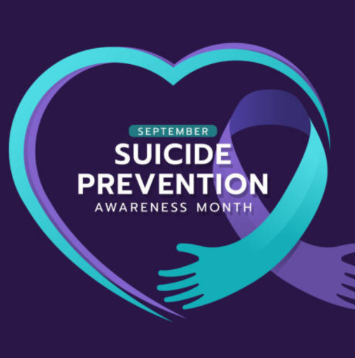
Figure 19: Image of a heart with wording inside-September Suicide Prevention Awareness Month
September is recognised worldwide as Suicide Awareness Month, with 10 September observed as World Suicide Prevention Day. This period is dedicated to raising awareness about mental health, reducing stigma, and strengthening support for those at risk. While suicide affects people across all walks of life, it is important to highlight how it uniquely impacts people who are blind or visually impaired.
Living with blindness or low vision can present challenges that go beyond physical barriers. Many individuals face social isolation, unemployment, limited access to education, and daily discrimination. These factors, compounded by misconceptions about disability, can contribute to feelings of exclusion or hopelessness. Studies have shown that people with visual impairments are at an increased risk of depression and anxiety, which are both significant risk factors for suicidal thoughts and behaviours.
The impact is not only emotional but also practical. Reduced accessibility to mental health resources, counselling services, or even suicide hotlines can mean that people who are blind do not always receive the same level of support as their sighted peers. This gap makes it essential for awareness campaigns to be inclusive, ensuring that prevention resources are available in braille, audio, large print, and accessible digital formats.
Suicide Awareness Month reminds us that prevention is better than cure & it requires community, compassion, and proactive inclusion. For blind and visually impaired people, this means:
- Ensuring accessible mental health services.
- Creating opportunities for social participation.
- Providing peer support networks within the blind community.
- Challenging stigma both around mental health and disability.
By raising awareness, we can encourage open conversations, promote understanding, and create pathways of hope. Suicide is preventable, and with inclusive, accessible support systems, people who are blind or visually impaired can thrive, knowing that their lives and voices matter.
Sunflower Day!
May you shine like the Sun and blossom like a Sunflower! Sunflowers are native to North America and have long been symbols of warmth, positivity, and resilience. Their bright yellow petals follow the sun, a phenomenon called heliotropism. In South Africa, Sunflower Day is observed in September and is linked to the Sunflower Fund, which raises awareness about stem cell donation and support for those living with blood cancers and other life-threatening conditions. Wearing a sunflower bandana has become a proud symbol of hope and solidarity.
A Poem for Sunflower Day
The sunflower stands so tall and bright,
Its face turns gladly to the light.
A golden crown, a cheerful glow,
It teaches us to rise and grow.
On Sunflower Day, we wear the hue,
Of yellow petals, bold and true.
A sign of hope, of life renewed,
Of kindness shared and strength pursued.
So plant a smile, spread love around,
Like sunflowers rising from the ground.
For every heart, both near and far,

Figure 20: Image of Sunflowers
For social media Engagements please Follow us on:
Facebook – Blind SA
Instagram – blind_sa_
Youtube – @blindsa5438
Tik Tok – @blind.sa
